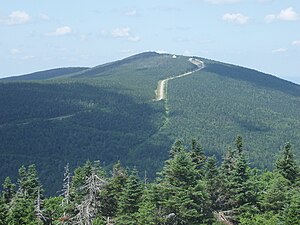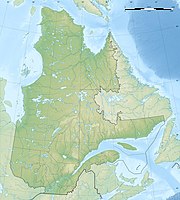Parc national du Mont-Mégantic
|
Parc national du Mont-Mégantic
|
||
|
Summit region of Mont-Mégantic |
||
| location | Quebec , Canada | |
| surface | 54.86 km² | |
| WDPA ID | 66627 | |
| Geographical location | 45 ° 27 ' N , 71 ° 10' W | |
|
|
||
| Setup date | 1994 | |
| administration | Parcs Québec, SEPAQ | |
The Parc national du Mont-Mégantic is one of the current 27 national parks in the Canadian province of Québec . There a parc national corresponds to what is called a provincial park in the other provinces . The park is operated by Sépaq ( French Société des établissements de plein air du Québec or English Society of outdoor recreation establishments of Quebec ).
The task of the 54.86 km² park, which was established in 1994 in the extreme south of the province south of the St. Lawrence River , is to protect and represent the area around the southern flank of the eponymous mountain, which is considered the northern foothills of the Appalachian Mountains . The Réserve écologique Samuel-Brisson , a strict nature reserve, extends on the north flank . The park is also registered as an Important Bird Area , which means that, according to global criteria, it is considered to be important for species and biotope protection, especially for birds ( zone importante pour la conservation des oiseaux ). The Observatoire du Mont Mégantic has been located on the top of the mountain since 1978 .
history
In 1978 an observatory was set up on the 1111 m high, second highest mountain in the province. On September 21, 2007, a so-called Dark-sky preserve or Réserve de ciel étoilé was created around this facility . In this area, artificial light is avoided as far as possible in order to enable the observatory to work, which cannot tolerate interfering lights. In order to give the public access to observations of this kind, the Observatoire populaire du Mont-Mégantic was created, a station that is accessible to all and equipped with a 61 cm telescope.
In 2005 the park had 40,000 visitors.
In 2007, the park and its surroundings, covering an area of 58.45 km², were designated by the International Dark Sky Association (IDSA) as a Dark Sky Preserve ( light protection area , Mont-Mégantic International Dark Sky Reserve ). The IUCN runs the area as a DSAG class 1 Starlight Reserve , as it serves to protect the observatory from impairment .
Flora and fauna
The flora on Québec's second highest mountain is very unusual, as the pine forests there are mainly interspersed with wood sorrel . It persists mainly in the higher regions, which are characterized by numerous stumps of dead trees. Most of the trees are around 100 years old, some over 160. Around 3.9 km² areas at the heights of Mont Mégantic, Saint-Joseph and Victoria are therefore protected and are considered to be exceptional forest ecosystems (écosystème forestier exceptionnel). The more easily accessible areas on the plateau, however, were still cleared in the 1950s.
In addition, the road that leads to the summit has not only caused massive damage, it has also increased erosion. It is investigated how the vegetation recovers from the massive interventions under the conditions of extreme climatic requirements. At the same time, an attempt is made to put a stop to erosion with covers and other means. Added to this is the introduction of mercury, which has been known since the 1990s.
Although there are some suitable wetlands such as the Marais des Scots , no turtles have been spotted so far. In 1998, however, 90 species of beetles were found in one examined place. Spiders have not yet been studied.
See also
literature
- The research scientifique dans les Parcs nationaux québécois. Priorités et potentiels de recherche , published by Parcs Québec and Sépaq, undated, pp. 92–94.
Web links
- Parc national du Mont-Mégantic , Sépaq (French)
- ASTROLab du parc national du Mont-Mégantic
Individual evidence
- ↑ Patrick Galois, Martin Quellet, Christian Fortin: Les parcs nationaux du Québec: herpétofaune, intégrité écologique et conservation, in: La société provancher d'histoire naturelle du Canada (ed.): Parcs et Aires protégées, 2007, p. 79.
- ↑ Celia A. Evans, Tom C. Hutchinson: Mercury Accumulation in Transplanted Moss and Lichens at High Elevation Sites in Quebec , in: Water, Air and Soil Pollution 90 (1996) 475-488.

